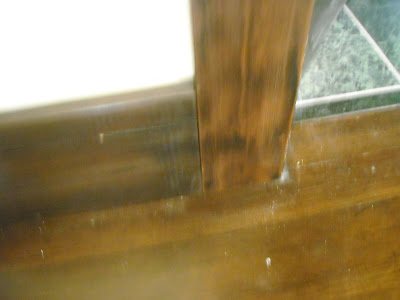Today was filled with excitement because we barbecued the brisket today. Here it is after sitting over night with a gentle rub of salt and fresh ground pepper that we drizzled over both sides of the meat.
Before going into those details, lets talked about varnishing.After getting home from church, we went to work on the floor. Today was coating number three for the varnishing.
As before, the sanding was hard and took some time, the varnishing took ten minutes. We are happy with the results and consider the varnishing project to be complete.Now lets talk about barbecuing.I got up at 7:00 and fired up ten charcoal brickets in my chimney. I had already prepared the 116 bricket snake that lined the perimeter of the kettle. I placed five chunks of hickory evenly around the snake.
I modified this picture in Photoshop to show the snake. It was really dark. You can see the 8 inch gap in the snake at the bottom of the picture. The pans held 6 cups of water. I guess to keep things moist.I poured the starter charcoal into the right end side of the snake, replaced the grill and put the meat on so that the fatty point was over the gap.
I stuck a meat thermometer into the thickest part of the point and left for church.
By the time we got home, the meat had been roasting for three and a half hours and was already at 170 degrees.
We opened it up and wrapped the meat in foil. This method is called the Texas Crutch. I added a chimney full of charcoal to the gap, replaced the meat in the same position as before and let it go. The plan was to leave it on for another two hours or when it reached 205 degrees.
At this point, we were way ahead of schedule. It reached 205 degrees in about an hour and 15 minutes. It was only 12:15 and we told our guests to arrive at five.
We were in the middle of varnishing so I shut down the vents and let it stay on the grill.
When we got back to it, a half hour had passed and the temperature was at 210 degrees. It had been on the grill for five and a half hours. We had been planning on eight hours.
We pulled the brisket and put it upside down in a cooler. The recipe called for it to be in the cooler for three hours were it would drop to 160 degrees.
We pulled it out after four hours. The cooler was warm and the meat was 140 degrees. Still warm enough to eat.It came out perfect. It was tender and juicy and melted in you mouth.The recipe we followed came from "Cook's Country" on PBS. We recorded the episode and watched it several times, writing down the details until we felt pretty familiar with what to do.
We definitely plan on doing this again and using the same method to slow cook ribs or a turkey.
The only thing I would do differently next time is to close the top and bottom vents half way. We left them wide open and I think that is why it cooked so fast.




























